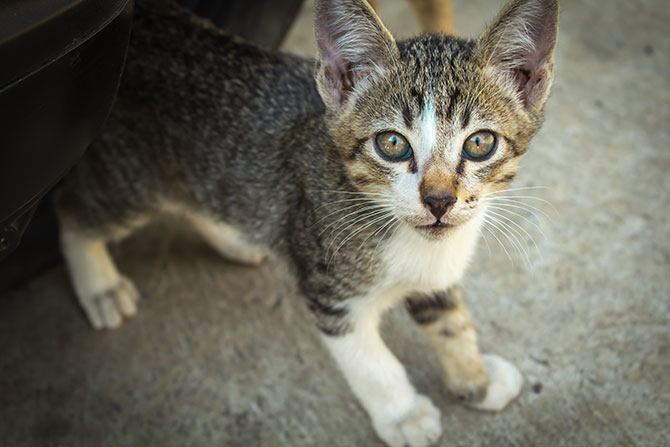Kittens who get no exposure to humans in their first few weeks of life can quickly become feral. However before you think hope is lost, there are many things you can do to socialise or tame kittens so that they can feel comfortable in the company of humans.
If the kittens are less than four weeks old, it will only take a few days to socialise them, however older kittens can require up to four weeks or even longer. The more time you spend with a kitten, the quicker they will tame. If a kitten is older than 3 months, however, it is unlikely that they will ever be fully socialised.
If you’ve found yourself looking after one or more wild kittens, here are ten of our best tips to help you socialise them.
1. Keep them confined to a small space
Don’t let feral kittens have free rein in your house as they need to be confined during the initial stages of socialisation. You can keep the kittens in a small room such as the bathroom or laundry, or in a cage or pet carrier that is raised off the floor. If your kittens are extremely small, a nylon cage is often better than one made from wire.
Be sure that the room has adequate ventilation, is relatively quiet, and has no way for them to escape. Remove anything that may result in kitten injury, and try to seal any small spaces where they may crawl and hide, as it may be extremely difficult to coax them back out.
Include plenty of comfortable bedding, a small litterbox, dishes for food and water, and something with your lingering scent for them to cuddle into, such as a towel or small blanket.
2. Keep them separate
Where possible, you should keep a litter of kittens separate. This will make socialisation easier and allow each of them to develop their own personalities. If you can’t separate the litter, make it a priority to spend time alone with each of the kittens.
3. Make them feel safe
Avoid making loud noises in the area where you keep the kittens, and wear slippers if you have noisy floors so as to mask the sound. A clock wrapped in a blanket can be very comforting for a small kitten, as it replicates the sound of its mother’s heartbeat.
4. Be consistent with feeding
Food is one of the key elements for taming feral cats. Ensure that there is always dry food available and top it with a small portion of wet food at least twice a day. Avoid giving your kitten cow’s milk, as this can make them feel sick. You may find that the kitten won’t want to eat if you’re around. As older kittens can be harder to handle, you may want to introduce their food on a spoon through the cage. With persistence and patience, your kitten will begin to associate you with food.
5. How to handle your kitten
This will very much depend on the kitten itself, its age, and its temperament. Very young kittens can be picked up immediately, although you may prefer to wear gloves at first as kitty’s teeth and claws can be extremely sharp! Be confident and very gentle when handling your kitten. Wrap it in a towel, and offer some wet food on a spoon. If they’re not showing any interest, try dabbing a tiny bit of food onto the end of its nose.
6. Make time for short but frequent petting sessions
To pet a feral kitten, start behind its head and slowly move into petting the face, chin, and behind the ears. Always do this gently, and try to talk to the kitten as you do so. Incorporate short combined feeding and petting session with your kitten as many times during the day as you can, and use a small brush to replicate the grooming it would have received from its mother.
The progress you make with petting will once again depend on the age and temperament of your kitten. You will start to see daily improvements, however, as they get used to you and trust you more. Perhaps the kitten will fall asleep on your lap, or come towards you for a bit of food. Hearing your kitten purr for the first time, or starting to chase a bit of string, are all very satisfying signs. However, try to discourage it from biting, scratching, or playing with your hands.
7. Moving on from the cage
Once your kitten has stopped running away from you, starting to come to you for food or petting instead, you can now move them from the cage or crate to a small, kitten-proofed room. If you’re looking after other kittens from the litter, they can also be reunited now.
8. Introduce them to other people and cats
Let your kitten meet other people. Encourage visitors to use low voices and approach them slowly, however. It may also help to leave a TV or radio on during the day to allow the kittens to get used to the sound of human voices. As long as your kitty is healthy, you can begin to introduce it to other socialised cats.
9. Discouraging night time activities
If you find that your kittens are awake at night, try offering more play and socialisation sessions during their day. It may also help to cover their cage with a blanket at night.
10. Keep your vet involved
Don’t forget to take your kitten to your local vet for a wellness visit, and to ensure that they get the necessary vaccinations. The vet will also be able to assess the age of your kitten if necessary, and advise you on sterilisation so that your new kitten doesn’t perpetuate the feral cat population.
For more advice on how to socialise feral kittens, watch this video for plenty of helpful suggestions.







Leave A Comment